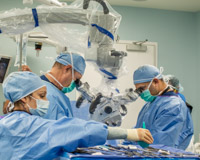The discovery of T.E.A.M. Disease by Dr. Robert S. Bray, Jr., is a major breakthrough for patients suffering from undiagnosed upper back pain and loss of function in the lower extremities that can lead to chronic pain and permanent paralysis.
T.E.A.M. disease is an arteriovenous malformation (AVM) that is located in the epidural space of the spinal column in the thoracic region. This area is outside the spinal cord but inside the vertebral canal of the spinal column. AVMs are rare, effecting about 300,000 people according to the National Institutes of Health and are well documented in the medical literature. However, they have never been previously identified in this particular part of the spine.
This collection of arteries and veins becomes a tangled web and can wrap around the spinal cord causing pressure on the cord and in some cases deprive it of oxygen. These AVMs seem to occur over multiple levels and are also encased in fatty tissue called a lipoma, which is fairly common but generally benign and does not lead to the significant neurological deficit seen in this condition.
Depending on the progression of the disease, surgery with a skilled neurosurgeon is the recommended course of action to remove the growths. Dr. Bray’s patients who have undergone an outpatient procedure called an intralaminar laminotomy have all seen significant reversal of their symptoms.
Using a minimally invasive approach under a high-powered microscope, small incisions are made in order to make holes into the epidural space and remove each AVM. Recovery times have ranged from three to 14 months, based on the extent of damage to the spinal cord prior to surgery. To date, once the AVMs have been removed there is no evidence of their re-growth.
While the symptoms of this disease clearly indicate a neurological issue, previously traditional MRI or CT myelogram scans failed to show the AVMs in this unique location. Therefore, patients were left without a proper or wrong diagnosis and declining health. Working with Dr. Rachael Gordon, a neuroradiologist, a special gadolinium dye sequencing protocol was developed to image the presence of these specific AVMs. Used in conjunction with a thorough clinical examination patients can be accurately diagnosed.
Symptoms of this disease can be similar to other conditions such as multiple sclerosis, transverse myelitis, or spinal cord myelopathy, which basically means physicians know there is spinal cord involvement, but don’t see any evidence of a lesion or mass therefore there is no significant treatment for the condition.
Patients with T.E.A.M. disease have all displayed significant upper back pain, especially at night, leg spasms, overactive reflexes, clonus, loss of balance and difficulty walking up and down stairs. In the patients that Dr. Bray has seen these symptoms became progressively worse over time and were not brought on by a specific incident.
In two years, Dr. Bray has identified 12 patients with this disease primarily young women ranging in age from 20-45. Further research and study is needed to determine what segment of the population is at risk and possible causes, although previous research on AVMs has indicated this could be a congenital condition that is present at birth. As to the trigger for the onset of symptoms, whether it is a slow progression or possibly a traumatic injury remains unknown. This discovery may also provide the keys to unlocking a number of other spinal conditions that have eluded physicians for many years and help improve the lives of thousands of people.
For more information or to schedule an appointment for an evaluation please contact us 310.574.0400.

About the author
discmdgroup DISC Sports & Spine Center (DISC) is a national leader in minimally invasive spine surgery, orthopedic surgery, and sports medicine care. Our spine surgeons set the standard in artificial disc replacement, spine fusion, discectomy, microdiscectomy and the full spectrum of spine procedures. The group’s orthopedic surgeons advance the state of joint preservation surgery and total joint replacement, including total knee replacement as well as total hip replacement. Our flagship surgery centers based in Newport Beach, Marina del Rey, and Carlsbad serve patients local to Los Angeles, Orange County and San Diego, as well as the rest of the country. Read more articles by discmdgroup.





